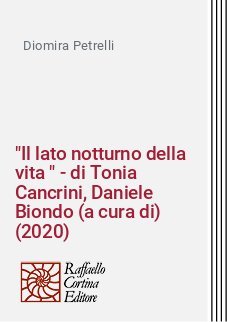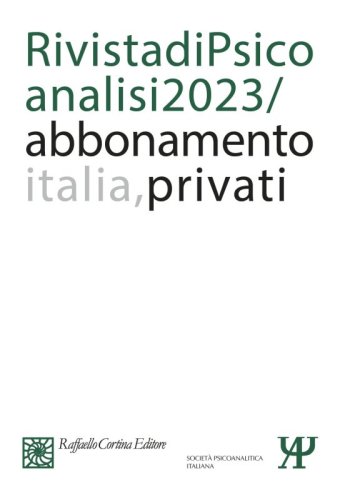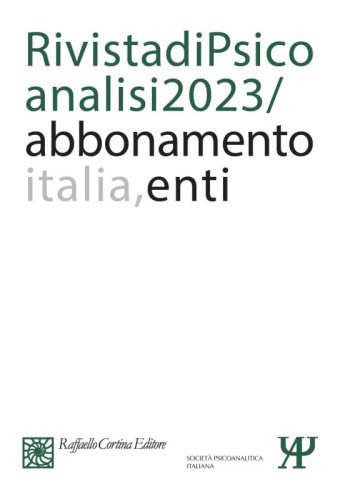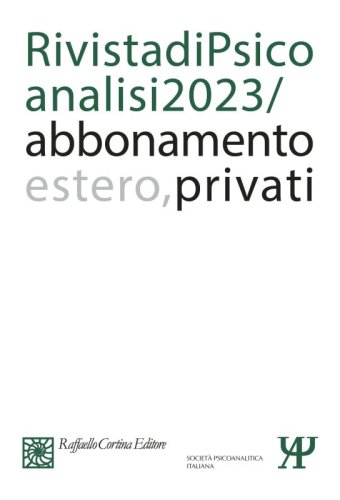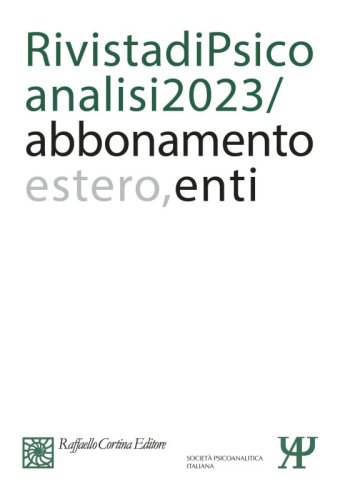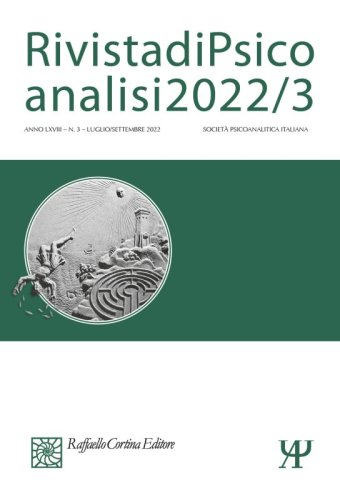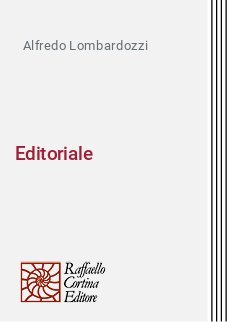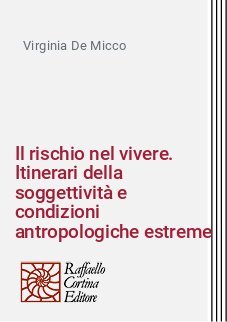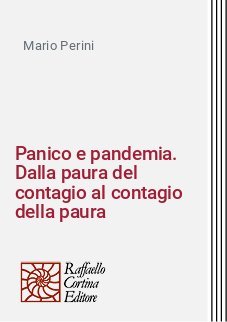Raffaello Cortina Editore
Abbonamento Rivista di psicoanalisi 2023 - Privati Italia
Autori vari
editore: Raffaello Cortina Editore
Abbonamento Rivista di psicoanalisi 2023 - Enti Italia
Autori vari
editore: Raffaello Cortina Editore
Annual subscription Rivista di psicoanalisi 2023 Individuals, Rest of the World
Autori vari
editore: Raffaello Cortina Editore
Annual subscription Rivista di psicoanalisi 2023 - Institutional, Rest of the World
editore: Raffaello Cortina Editore
Rivista di Psicoanalisi 2022/3
LXVIII - (3) - Luglio/Settembre 2022
rivista: La Rivista di Psicoanalisi
pagine: 360
Editoriale
rivista: La Rivista di Psicoanalisi
fascicolo: Rivista di Psicoanalisi 2022/3
di Alfredo Lombardozzi
Il rischio di non vedere. L’inquinamento luminoso e il valore dell’oscurità
rivista: La Rivista di Psicoanalisi
fascicolo: Rivista di Psicoanalisi 2022/3
di Cosimo Schinaia
Il rischio di non vedere. L’inquinamento luminoso e il valore dell’oscurità
L’eccesso di luminosità e il conseguente inquinamento luminoso hanno tolto spazio al valore del buio, al significato che può avere la percezione dell’oscurità. Sono molti i danni a livello psichico, fisico, scientifico e culturale che l’inquinamento luminoso può provocare. Due vignette cliniche illustrano specificamente quanto significativo possa essere in termini emotivi e relazionali un eccesso di luminosità ambientale o, all’opposto, l’irruzione del buio nella stanza di analisi.
Parole chiave: Buio, illuminazione, invisibile, luce, percezione e astensione visiva.
The risk of not seeing. Light pollution and the value of darkness. Excessive brightness and the resulting light pollution have taken away space from the value of darkness, the meaning that the perception of darkness can have. There are many harms at the psychological, physical, scientific and cultural levels that light pollution can cause. Two clinical vignettes specifically illustrate how significant in emotional and relational terms an excess of ambient brightness or, conversely, the irruption of darkness into the analysis room can be.
Key words: Darkness, light, lighting, invisible, visual perception and abstention.
Le risque de ne pas voir. Pollution lumineuseet la valeur des ténèbres. L’excès de luminosité et la pollution lumineuse qui en résulte ont fait perdre de la valeur à l’obscurité, au sens que peut avoir la perception de l’obscurité. La pollution lumineuse peut causer de nombreux dommages psychologiques, physiques, scientifiques et culturels. Deux vignettes cliniques illustrent précisément l’importance qu’un excès de lumière ambiante peut avoir sur le plan émotionnel et relationnel ou, au contraire, l’invasion de l’obscurité dans la salle d’analyse.
Mots Clés: Illumination, invisible, lumière, obscurité, perception et abstention visuelle.
El riesgo de no ver. La contaminación lumínicay el valor de la oscuridad. El exceso de luminosidad y la consiguiente contaminación lumínica han quitado valor a la oscuridad, al significado que puede tener la percepción de la oscuridad. Son muchos los daños psicológicos, físicos, científicos y culturales que puede causar la contaminación lumínica. Dos viñetas clínicas ilustran en concreto la importancia que puede tener en el sentido emocional y relacional un exceso de luz ambiental o, por el contrario, la invasión de la oscuridad en el consultorio de análisis.
Palabras Clave: Iluminación, invisible, luz, oscuridad, percepción y abstención visual.
Das Risiko, nicht zu sehen. Lichtverschmutzung und der Wert der Dunkelheit. Das Übermaß an Helligkeit und die daraus folgende Lichtverschmutzung haben dem Wert der Dunkelheit, der Bedeutung, die die Wahrnehmung der Dunkelheit haben kann, den Platz genommen. Die Schäden auf psychischer, physischer, wissenschaftlicher und kultureller Ebene, welche die Lichtverschmutzung hervorrufen kann, sind zahlreich. Zwei Fallvignetten veranschaulichen, wie bedeutsam ein Übermaßan Umgebungshelligkeit oder im Gegenteil der Einfall des Dunkels in das Analysezimmer in emotionaler und relationaler Hinsicht sein kann.
Schlüsselwörter: Dunkel, Illumination, Unsichtbares, Licht, Wahrnehmung und visuelle Enthaltung.
Il rischio nel vivere. Itinerari della soggettività e condizioni antropologiche estreme
rivista: La Rivista di Psicoanalisi
fascicolo: Rivista di Psicoanalisi 2022/3
di Virginia De Micco
Il rischio nel vivere. Itinerari della soggettività e condizioni antropologiche estreme
Partendo dall’incompletezza costitutiva dell’umano vengono analizzate le vie della soggettivazione e dell’umanizzazione attraverso il lavoro della cultura, con i connessi rischi disumanizzanti che si riaffacciano costantemente nelle condizioni di crisi storico-culturali. La migrazione forzata, la pandemia e la guerra vengono analizzate come «contesti traumatici» che configurano situazioni antropologiche ‘estreme’, capaci di influenzare profondamente la costruzione delle soggettività e dei processi di trasmissione culturale. In particolare viene esaminata la dimensione psichica ed antropologica del rischio che emerge nelle esperienze di relazione con lo straniero e con il nemico, luoghi fantasmatici oltre che configurazioni storiche in cui l’intreccio umano/disumano diventa particolarmente evidente.
Parole Chiave: Confine, lavoro culturale, straniero, trauma, umano/disumano.
The risk in living. Itineraries of subjectivity and extreme anthropological conditions. Starting from the constitutive incompleteness of the human, the ways of subjectivation and humanisation through the work of culture are analysed, with the associated dehumanising risks that constantly resurface in conditions of historical and cultural crises. Forced migration, pandemics and war are analysed as «traumatic contexts» that configure ‘extreme’ anthropological situations capable of profoundly influencing the construction of subjectivities and processes of cultural transmission. In particular, the psychic and anthropological dimension of risk that emerges in experiences of relations with the foreigner and the enemy is examined, phantasmatic places as well as historical configurations in which the human/dehuman interweaving becomes particularly evident.
Key Words: Border, cultural work, foreigner, trauma, human/dehuman.
Le risque de vivre. Itinéraires de la subjectivité et des conditions anthropologiques extrêmes. À partir de l’incomplétude constitutive de l’humain, les voies de subjectivation et d’humanisation à travers le travail de la culture sont analysées, avec les risques de déshumanisation qui y sont associés et qui réapparaissent constamment dans les conditions de crise historico-culturelle. La migration forcée, la pandémie et la guerre sont analysées comme des «contextes traumatisants» qui configurent des situations anthropologiques «extrêmes», capables d’influencer profondément la construction des subjectivités et les processus de transmission culturelle. En particulier, la dimension psychique et anthropologique du risque qui émerge dans les expériences de relations à l’étranger et à l’ennemi est interrogée, lieux fantomatiques outre que des configurations historiques dans lesquelles l’entrelacement humain/inhumain devient particulièrement évident.
Mots Clés: Étranger, frontière, humain / inhumain, trauma, travail culturel.
El riesgo de vivir. Itinerarios de subjetividad y condiciones antropológicas extremas. A partir de la incompletitud constitutiva de lo humano, se analizan las formas de subjetivación y humanización a través del trabajo de la cultura, con los riesgos deshumanizantes asociados que reaparecen constantemente en las condiciones de crisis histórico-cultural. La migración forzada, la pandemia y la guerra se analizan como «contextos traumáticos» que configuran situaciones antropológicas «extremas», capaces de influir profundamente en la construcción de subjetividades y procesos de transmisión cultural. En particular, se examina la dimensión psíquica y antropológica del riesgo que emerge en las experiencias de relación con lo extraño y con el enemigo, lugares fantasmales así como configuraciones históricas en las que el entrelazamiento humano/inhumano se hace particularmente evidente.
Palabras Clave: Extranjero, frontera, humano/inhumano, trabajo cultural, trauma.
Das Risiko im Leben. Wege der Subjektivität und extreme anthropologische Bedingungen. Ausgehend von der konstitutiven Unvollständigkeit des Menschen werden die Wege der Subjektivierung und der Humanisierung durch die Kulturarbeit analysiert, mit den damit verbundenen entmenschlichenden Risiken, die unter historisch-kulturellen Krisenbedingungen immer wieder auftauchen. Erzwungene Migration, Pandemie und Krieg werden als ‚traumatische Kontexte‘ analysiert, die ‚extreme‘ anthropologische Situationen darstellen, die imstande sind, die Konstruktion der Subjektivität und der Prozesse kultureller Übertragung tiefgreifend zu beeinflussen. Untersucht wird insbesondere die psychische und anthropologische Dimension des Risikos, das in den Beziehungserfahrungen mit dem Fremden und dem Feind auftritt, phantasmatische Orte und historische Konfigurationen, in denen die Verknüpfung menschlich/unmenschlich besonders evident wird.
Schlüsselwörter: Grenze, kulturelle Arbeit, Fremder, Trauma, menschlich/unmenschlich.
Panico e pandemia. Dalla paura del contagio al contagio della paura
rivista: La Rivista di Psicoanalisi
fascicolo: Rivista di Psicoanalisi 2022/3
di Mario Perini
Panico e pandemia. Dalla paura del contagio al contagio della paura
Le epidemie non sono solo un problema sanitario, implicano anche processi sociali, culturali, politici, finanziari e anche psicologici, che richiedono approcci complessi e multidimensionali. Dopo aver approfondito il concetto di «epidemia di paura» e le sue radici inconsce, l’articolo esamina la «vexata quaestio» se questa pandemia abbia provocato delle ricadute negative sulla struttura e sulla cultura sociale o se ne abbia solo smascherati i difetti preesistenti e considera l’esigenza di costruire spazi riflessivi in grado di aiutare le persone ad orientarsi nell’incertezza evitando il rischio di un agire difensivo in balìa di fantasmi e pregiudizi. In conclusione si postula l’idea che il pensiero psicoanalitico, soprattutto nelle declinazioni gruppo-e socio-analitiche, possa essere un aiuto efficace per affrontare la paura e per ispirare una leadership «sufficientemente buona» in grado di governare le situazioni di incertezza ricorrendo alla «capacità negativa».
Parole Chiave: Capacità negativa, epidemia di paura, gruppo, leadership, Pandemia, stigmatizzazione.
Panic and pandemic. From fear of contagion to contagion of fear. Epidemics are not only a health problem, they also involve social, cultural, political, financial and even psychological processes, which require complex and multidimensional approaches. After delving into the concept of the «epidemic of fear» and its unconscious roots, the article examines the «vexata quaestio» as to whether this pandemic has caused negative repercussions on social structure and culture or whether it has merely unmasked its pre-existing flaws, and considers the need to construct reflexive spaces capable of helping people to orient themselves in uncertainty, avoiding the risk of defensive action at the mercy of ghosts and prejudices. In conclusion, the idea is postulated that psychoanalytic thinking, especially in its group-and socio-analytic declinations, can be an effective aid in facing fear and inspiring «good enough» leadership capable of governing situations of uncertainty by resorting to «negative capacity».
Keywords: Fear epidemic, group, leadership, negative capability, stigmatisation.
Panique et pandémie. De la peur de la contagion à la contagion de la peur.Les épidémies ne sont pas seulement un problème de santé, elles impliquent également des processus sociaux, culturels, politiques, financiers et même psychologiques, qui nécessitent des approches complexes et multidimensionnelles. Après avoir exploré le concept d’«épidémie de peur» et ses racines inconscientes, l’article examine la «vexata quaestio» si cette pandémie a causé des répercussions négatives sur la structure et la culture sociale ou si elle n’a fait que démasquer ses défauts préexistants et considère la nécessité de construire des espaces réflexifs capables d’aider les personnes à s’orienter dans l’incertitude en évitant le risque d’une action défensive à la merci des fantômes et des préjugés. En conclusion, on postule l’idée que la pensée psychanalytique, en particulier dans les déclinaisons groupales et socio-analytiques, peut être une aide efficace pour affronter la peur et inspirer un leadership «assez bon» capable de gouverner les situations d’incertitude en recourant à la «Capacité Negative».
Mots Clés: Capacité négative, épidémie de peur, groupe, leadership, pandémie, stigmatisation.
Pánico y pandemia. Del miedodel contagio al contagio del miedo. Las epidemias no solo son un problema sanitario, también involucran procesos sociales, culturales, políticos, financieros e incluso psicológicos, que requieren abordajes complejos y multidimensionales. Después de haber explorado el concepto de «epidemia de miedo» y sus raíces inconscientes, el artículo examina la «vexata quaestio» si esta pandemia ha causado repercusiones negativas en la estructura y cultura social o si sólo ha desenmascarado sus defectos preexistentes y considera la necesidad de construir espacios de reflexión capaces de ayudar a las personas a orientarse en la incertidumbre evitando el riesgo de una acción defensiva a merced de fantasmas y prejuicios. En conclusión, se postula la idea de que el pensamiento psicoanalítico, especialmente en las declinaciones grupales y socio analíticas, pueda ser una ayuda eficaz para enfrentar el miedo e inspirar una leadership «suficientemente buena» capaz de gobernar situaciones de incertidumbre recurriendo a la «capacidad negativa».
Palabras Clave: Capacidad negativa, epidemia de miedo, estigmatización, grupo, liderazgo, pandemia.
Panik und Pandemie. Von der Angst vor der Übertragungzur Übertragung der Angst. Epidemien sind nicht nur ein gesundheitliches Problem, sondern bringen auch soziale, kulturelle, politische, finanzielle und psychologische Prozesse mit sich, die komplexe und mehrdimensionale Ansätze erfordern. Nach eingehender Untersuchung des Konzepts der «Epidemie der Angst» und ihrer unbewussten Wurzeln geht der Artikel der «vexataquestio» nach, ob diese Pandemie negative Auswirkungen auf die soziale Struktur und Kultur verursacht oder ob sie lediglich bestehende Mängel enthüllt hat, und betrachtet das Bedürfnis nach der Konstruktion reflexiver Räume, die den Menschen helfen, sich in der Unsicherheit zu orientieren und das Risiko eines defensiven Handelns, das Phantasmen und Vorurteilen ausgeliefert ist, zu vermeiden. Zuletzt wird der Gedanke vorgebracht, dass das psychoanalytische Denken, insbesondere in den Gruppen- und sozio-analytischen Ausprägungen, ein wirksames Hilfsmittel sei kann, um der Angst zu begegnen und «ausreichend gute» Leadership zu inspirieren, die in der Lage ist, Situationen der Ungewissheit durch den Rückgriff auf die «negative Fähigkeit» zu bewältigen.
Schlüsselwörter: Epidemie der Angst, Gruppe, Leadership, negative Fähigkeit, Pandemie, Stigmatisierung.
 ita
ita
 Eng
Eng


!["De l’informe aux configurations psychiques. De (peindre) les processus [Dall’informe alle configurazioni psichiche. Dipingere (dipendere dai) i processi]" – di Jean-Paul Matôt (2020)](https://rivisteraffaellocortina.mediabiblos.it/copertine_thumb/raffaello-cortina-editore/mediabiblos_de-linforme-aux-configurations-psychiques-de-peindre-les-processus-dallinforme-alle-confi-RDPS2022_4_15.jpg?ts=1673861364)
!["So will ich mir entfliehen. Sigmun Freud Italienreisen [Così voglio sfuggire a me stesso. I viaggi in Italia di Sigmund Freud]" - di Marina D'Angelo (2020)](https://rivisteraffaellocortina.mediabiblos.it/copertine_thumb/raffaello-cortina-editore/mediabiblos_so-will-ich-mir-entfliehen-sigmun-freud-italienreisen-cosi-voglio-sfuggire-a-me-stesso-i-viaggi-RDPS2022_4_16.jpg?ts=1673861615)
